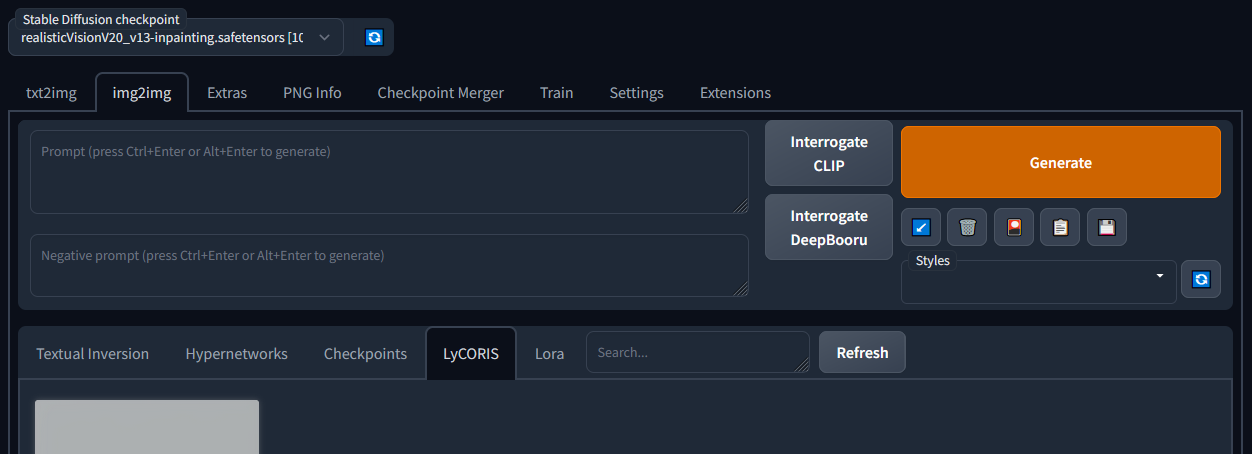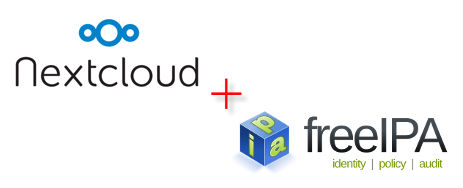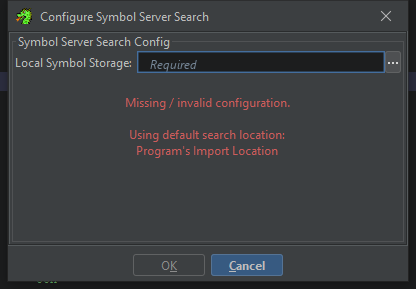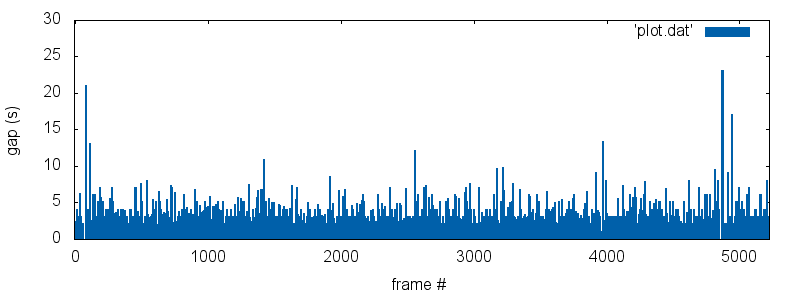VoiceCraft is a text to speech (TTS) and speech editing project written by Puyuan Peng which provides some interesting results for voice cloning with just a few seconds of input data. If you’re looking to try this tool out yourself but have hit some hurdles, I’ve created this guide which walks you through its use on Windows using Docker. You should have a little familiarity with Python to be able to use this tool.
Continue readingCategory Archives: How-To
How to download PDB symbols in Ghidra
About the only article I can find that references downloading symbols from a remote symbol server in Ghidra doesn’t seem to be current with at least version 10.4. This feature was added in the 10.0 release but it seems to have changed slightly since then.
With CodeBrowser loaded you’ll first need to configure your Local Symbol Storage directory using Tools -> Symbol Server Config.
Once you’ve selected your Local Symbol Storage directory you’re then able to add a remote symbol server via Additional Search Paths by hitting the + button. After clicking Ok you can then download symbols via File -> Load PDB File…, click Advanced > >, and then click Search All. If a PDB is available it will show up in the PDB Search pane, and then you can click Load to trigger the download.
How to fix certain H264 MP4s that cannot be imported into DaVinci Resolve
Recently I came across a set of video recordings that DaVinci Resolve would not import. According to its Media Storage viewer, the folder they were in was empty, except for one of the videos which was suspicious to me. These recordings played fine in multiple media players but most suggestions I could find for resolving the issue via Google either blamed the user, suggested they have to upgrade to DaVinci Resolve Studio, or worst of all – transcode the videos to a compatible format. Transcoding is time intensive and lossy, and Studio costs money, so let’s try to avoid either of those.
There are a couple ways to identify whether this is going to work for your video files.
Continue readingUsing LyCORIS in Dockerized automatic1111 Stable Diffusion web UI

If you’ve had trouble using LyCORIS in automatic1111 Stable Diffusion web UI chances are you’re using the Docker version. To get it to work, you’ll need to make a small change – but I’ll quickly lay out how to get it up and running in your container from start to finish.
Continue readingFixing Taiko no Tatsujin: The Drum Master! on Windows

Microsoft recently made BANDAI NAMCO’s “Taiko no Tatsujin: The Drum Master!” (TnT) available on Xbox for Windows – included with the GAME PASS no less – but it came with an important catch: it doesn’t work. Starting the game leaves you stuck at the title screen with a message, “After signing into a Microsoft account, please restart the game.”
Sitting around waiting for Microsoft to fix this is one option, but another is fixing it ourselves. The game is built using Unity and Microsoft allows you to set the game as Moddable opening the door to all sorts of opportunities. Since the game is a .NET application written in C#, there’s already a swath of utilities out there that make this relatively straightforward (and free!).
We’ll make use of the following roster of applications:
This won’t be an intensive tutorial on everything you need to know to go from idea (i.e., fixing sign in) to execution (i.e., writing a patch), but it should prime your mind for the kinds of things that are possible. If you want to skip to the end, there is a link to the GitHub repository which also includes a pre-compiled binary for use with BepInEx to fix the game.
Continue readingSolving WiFi connectivity issues for Wyze Cam v3 on Bell Home Hub 3000
If you’re a Bell customer in Canada trying to use a Wyze Cam v3 on your Bell Home Hub 3000 you may have experienced issues with it connecting to your WiFi during setup. In a standard Home Hub 3000 configuration, the Wyze Cam will report that it “Cannot connect to local network”. In order to fix this, you’ll need to separate your 2.4 GHz and 5.0 GHz SSIDs. This will have a negative impact on the ease of use for your WiFi when dealing with older devices, but it is the only way to get the Wyze Cam v3 to work properly.
Continue readingHow to use Cloudflare DNS for the Letsencrypt challenge with Bitwarden’s automatic setup
Bitwarden’s automatic setup script allows you to secure your server’s HTTPS connections using Letsencrypt via certbot but it does not provide control over the challenge type used to issue the certificate. If you wanted to use a DNS challenge and take advantage of the Cloudflare API for example, you’ll need to make some changes to the scripts.
As your docker user, follow the standard steps from the TL;DR guide, which I’ve linked to and copied here just for completion. I do not recommend copy and pasting commands like this without being sure of what you’re executing.
$ curl -Lso bitwarden.sh https://go.btwrdn.co/bw-sh && chmod +x bitwarden.sh
$ ./bitwarden.sh installYou can CTRL+C to stop the install once it begins prompting you for input. Edit the bitwarden.sh script and comment out the downloadRunFile calls (e.g., at the time of writing lines 109 and 118)
You can then download and apply this diff to ~/bwdata/scripts/run.sh
Once complete the standard install can be reinitiated
$ ./bitwarden.sh installInstalling CorentinJ’s Real Time Voice Cloning project on Windows 10 from scratch
Corentin Jemine (CorentinJ on GitHub) has a project called Real Time Voice Cloning available on GitHub that uses deep learning to take a voice as input and synthesize speech using its properties – in essence creating a “deep fake” of audio. Setting things up from scratch to get it working on Windows 10 involves using specific versions of software and can be a bit difficult for new users to figure out. I intend this as a reference guide for doing just that – assuming you are starting with a fresh Windows 10 install. This does not provide any instruction for using the cloning software once setup.
Continue readingIntegrating NextCloud 11 with FreeIPA 4

This is a perfect example of banging your head against the wall for a day. Integration information between FreeIPA and just about anything is hard to come by, so I decided to put this short guide together covering it and Nextcloud. This is just a drop in a bucket that desperately needs to be filled. As always, I will endeavour to explain how I figured this out because understanding the how and why is important! Ultimately this investigation resulted in me tracking down a bug in the LDAP app in Nextcloud, and a patch has been merged for the Nextcloud 12 release.
You’ll require a read-only System account in your FreeIPA instance. This is for Nextcloud to bind to for reading users and groups. Basic instructions for creating a user for this purpose are located here on the FreeIPA wiki.
With this in hand and the LDAP / AD Integration app enabled in your Nextcloud instance you can get to configuring. You should be aware of some of your basic configuration settings in FreeIPA, like your basedn which you can find in /etc/ipa/default.conf on your IPA server.
Measuring and graphing I-frame gaps in videos
I’ve been mired in IPTV related work for a while now, popping my head up occasionally to grab a breath and take a look at some other neglected things in my day-to-day job. It isn’t long before I’m back into it though, and all the time I’m picking up more knowledge about the world of TV.
One thing that was brought to me recently was some failures related to a network PVR system having trouble ingesting encrypted video content. According to the support team for the software, I-frames in the content were too far apart to ingest properly. The person working on the issue at our company was interested in seeing just how far apart they were, so I set to creating a little script to do just that.
It turned out to be relatively simple using ffprobe, which is part of the ffmpeg suite. Using that data, it’s then possible to plot the I-frame gaps with gnuplot.

